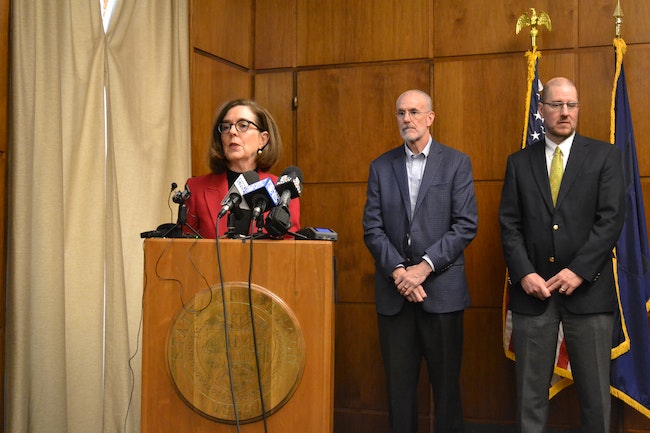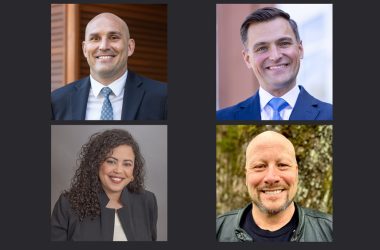 Gov. Kate Brown, Greg Miller, representative of the timber coalition, and Bob Van Dyke, of the Wild Salmon Center, announce the “historic” deal between logging and environmental interests Monday, Feb. 10. (Claire Withycombe/ Oregon Capital Bureau)
Gov. Kate Brown, Greg Miller, representative of the timber coalition, and Bob Van Dyke, of the Wild Salmon Center, announce the “historic” deal between logging and environmental interests Monday, Feb. 10. (Claire Withycombe/ Oregon Capital Bureau)
A new deal between Oregon’s timber industry and environmentalists to protect forest waters, modernize logging regulations and create a new conservation plan was announced Monday by Gov. Kate Brown and representatives of both interests.
The two sides have been at odds over policy and practices for decades, and this agreement aims to create a mediation process for updating the Oregon Forest Practices Act, passed in 1971.
The deal has three major points, the first being participation in a mediated process to change the Forest Practices Act by creating a conservation plan for all private timberland to protect threatened and endangered species and provide certainty for the timber industry.
The second piece is agreement over legislation in 202 Legislature that would require timber companies to notify nearby residents when aerial spraying of pesticides occurs and placing buffers along streams in southern Oregon forests that supply drinking water.
Finally, both sides agreed to drop forestry-related ballot initiatives and pending litigation. Environmental groups were working to get stricter forest rules into law by going to the voters this fall.
The agreement was joined by Hampton Lumber, Weyerhaeuser, Stimson Lumber, Roseburg Forest Products, Hancock Natural Resource Group and Port Blakely and the Oregon Small Woodlands Association on the timber side. Oregon Wild, Cascadia Wildlands, Beyond Toxics, the Wild Salmon Center, Oregon League of Conservation Voters and Rogue Riverkeeper highlight the environmental groups that signed on.
“This agreement is a genuine show of good faith from everyone involved,” Brown said at a news conference Monday morning “It ensures that all key voices will be heard in the process, including our vital small-woodland owners and Oregon’s federally recognized tribes. All sides have agreed this process of improving the Oregon Forest Practices Act will be informed by science and driven by science.”
Present in Brown’s ceremonial office to make the announcement with her was Bob Van Dyke of the Wild Salmon Center, representing the environmentalists, and Greg Mill, representing the forestry coalition.
“This is a shared recognition of the diverse benefits Oregon’s forests provide and the need for more meaningful dialogue around forest issues across the state,” Miller said.
According to Brown, the agreement between the two sides started when CEOs from the state’s largest timber companies approached her to find a way out of the embroiled dialogue surrounding timber practices and conservation. A series of conversations followed over the past four weeks that led to the agreement.
For Van Dyke, the agreement culminates more than 20 years of bickering and lawsuits between timber interests and environmentalists over what takes place in Oregon’s forests while Washington state led the way in conserving endangered species and protecting drinking water.
“While the Wild Salmon Center and many of the signers of this MOU today have been part of that 20 years of tension, the results have been a lack of trust, gridlock on forest policy and growing public demand for broader reform of laws,” Van Dyke said. “Today we’re starting a new approach.”
From a 10,000-foot level, the deal seems to favor environmental interests, but Miller believes that isn’t so.
According to Miller, the timber industry in Oregon is proud of its environmental stewardship and are equally interested in protecting water from aerial spraying of herbicides and using technology to let local residents know in real time of spraying.
“This is going to be a best-in-class practice for real-time notification, increasing the distance for the notifications, and having the spray records available within 24 hours,” Miller said. “Those kinds of things are difficult to develop in terms of execution on the ground…I think that’s the thing that got us over the hurdle.”
The agreement cites moving forward with a science-based approach, but often the two sides have offered different science to back their positions. Miller and Van Dyke agreed that while they guarantee there still will be differences of opinion, they’re committed to using science as a means to engage and work together on solutions.
Brown said that moving forward, the next step would be to shepherd through the Legislature new rules and buffers on aerial spraying in forests and notification for local residents. After that, both sides will update the Oregon Forest Practices Act and create the statewide habitat conservation plan.
Contact Reporter Sam Stites: [email protected] or 971-255-2480.









